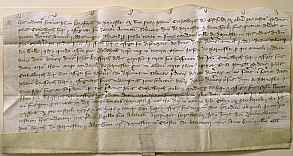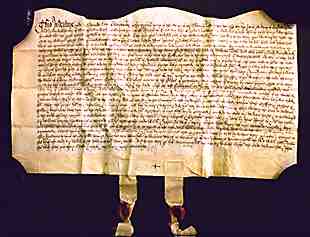




If you are looking at this page without frames, there is more information about medieval writing to be found by going to the home page (framed) or the site map (no frames).
| Chirographs, Indentures and Final Concords | ||
| The chirograph supposedly had its origins in Anglo-Saxon England, where the practice of using notaries to ratify legal documents was not continued generally after the Roman era. The chirograph was a legal agreement between two parties. The text of the document was copied out twice on the same sheet of parchment. Between the two versions was written in large letters the word CIROGRAPHUM, or some other word, and the sheet was cut in half through this word, often with a wavy cut. The logic of all this was that the agreement could be proven or ratified by the process of fitting together the two sheets, one of which was taken by each party to the agreement. | ||
 |
||
| A mid 12th century chirograph in which a priest, Alured, surrenders the tithes of Littleton so they may be granted to the monks of Cerisy, who in turn grant them to Gislebert for life for the payment of half a mark yearly (Queen's College, Oxford, Charters of Monk Sherborne). (From Salter 1929) | ||
| The above example deals briefly, and without excessive ceremonious language, with what appears to have been the major preoccupation of the 12th century; agreement to land title. There is a relic of a tag on the upper left corner of the document, where presumably the seal was attached. | ||
| As both halves of the document were retained by the interested parties, and there was usually no central record of the transaction, it is rare to locate both halves of the same chirograph. Like so many single sheet documents, they just fluttered away into the lost debris of history. | ||
 |
||
| The first few lines of a chirograph of 1160-1170 in which Gilbert de Monte makes a grant of land to the hospital of Brackley (Magdalen College, Oxford). (From Salter 1929) | ||
| The sample above is from a much more lengthy and formal document. Its intention is the same as a private charter. The notification SCIANT OMNES, the language in which it is phrased, the extensive witness list and the seal attached to the bottom of the document all recall the structure and appearance of a charter. The word CIROGRAPHUM cut in two at the top indicates that it is a chirograph. It is, in fact, a charter in the form of a chirograph. The two are not mutually exclusive. | ||
| A range of matters could be dealt with by chirograph. In fact, any kind of legal agreement between individuals or bodies could be set out in this form. They could be happy and mutually satisfactory agreements made willingly by both participants, or they could be drawn up as a result of action in the courts. Whatever the matters dealt with, or the form of words in which they were expressed, the chirograph was ratified by seal and by a list of witnesses who could testify to its validity. The other test of validity was the ability to match both halves of the document. There were no autograph signatures, and as with other legal letters and documents, verification was by a combination of oral testimony and visual symbols. | ||
 |
Chirograph or indenture of 1439 recording an agreement between John Kereforth of Barnesley and John Cothewath of Estfeld, from a private collection. | |
| It became usual to separate the two halves of a chirograph by a wavy or indented cut, hence the term indenture became common for this type of document. The terms chirograph and indenture are essentially synonymous. | ||
| The indenture survived as a legal form beyond the medieval period for legal agreements between consenting parties. Like charters, medieval indentures or chirographs were generally written in Latin, the language of formal legal documents. Later they developed their own English form. | ||
 |
A lease agreement of 1546 in the form of an indenture. The document is complete with wavy edge and two seals on tags. Below, the first line begins with This Indenture and is dated the 38th year of the reign of Henry VIII (Nottinghamshire Archives, DDFJ 7/80/11). By permission of Nottinghamshire Archives. | |
 |
||
| The above document records an agreement between a chantry priest, William Marshe and William and Joan Hall of Tickhill for a house with orchard and some meadow land for 15s 10d per year, with a parlour and chamber reserved for the owner in the house. Was our chantry priest an observant chap who had seen the writing on the wall and who was attempting to make a modest provision for an uncertain future? The little stories embedded in the big picture are what make history interesting. | ||
|
|
||
|
If you are looking at this page without frames, there is more information about medieval writing to be found by going to the home page (framed) or the site map (no frames). |
||